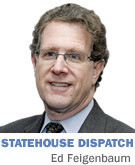Subscriber Benefit
As a subscriber you can listen to articles at work, in the car, or while you work out. Subscribe Now
 We’ve reached the halfway point of the 2015 legislative session, and you can now jettison a few preconceived notions.
We’ve reached the halfway point of the 2015 legislative session, and you can now jettison a few preconceived notions.
Some high-profile items that appeared in play at the outset—Sunday alcohol sales, an end to net metering and solar energy breaks, right-to-farm, allowing a candidate for the Legislature or statewide office to run concurrently for federal office—are likely dead. Meanwhile, as always, other issues entirely unanticipated in December—such as ISTEP testing protocols—blossomed to consume considerable attention.
As we enter the second half, keep your attention on the big measures that will dictate the flow of the final seven weeks.
The most is House Bill 1001, the biennial budget.
The bill contained major increments in K-12 education funding, but not every district shares equally in the largesse. Growing suburban districts benefit at the expense of shrinking urban and rural districts, and cash for vouchers and charter schools remains contentious.
Debate also grows over some enrollment figures used to build the House budget bill, and the disparity may actually be deeper.
The House budget crafted by Rep. Tim Brown, R-Crawfordsville, chairman of the Committee on Ways and Means, now faces surgery in the Senate Committee on Appropriations, where you should expect some fiscal liposuction to be performed by the chairman, Luke Kenley, R-Noblesville.
Kenley is the latest in a line of Senate fiscal pragmatists in charge of the budget that has stretched back three decades. He’s more concerned about making things balance than making philosophical statements, and colleagues are largely likely to defer to him on contours.
Look for Kenley to slightly pare back overall spending and fine-tune some of the school funding formula fixes and criminal incarceration solutions devised by Brown. However, the bottom line won’t emerge until after the mid-April revenue forecast.
The areas threatening to split lawmakers are education governance (and policy) matters and common construction wage repeal.
While a surprising number of House Republicans opposed both bills in final House votes, Senate Republicans can’t be counted on to follow suit.
Democrats will continue to try to score political points over the push to oust Democratic Superintendent of Public Instruction Glenda Ritz as chairwoman of the State Board of Education. Watch the dynamic over the bill that would change the state board appointment process to eliminate the need for geographic distribution and authorize legislative leaders to make appointments. Gov. Mike Pence, a Republican, isn’t enamored with that, and a coalition of convenience could be forged between the governor and Senate Democrats to block the change.
Education policy consensus has also been difficult to achieve.
Common construction wage repeal is fought on several battlegrounds, with television ads blaring, and the Indiana Association of Cities and Towns, conceivably a beneficiary of repeal, remaining neutral.
Rather than hearing the bill in the Senate Committee on Pensions and Labor, the natural substantive choice, leadership assigned it to the Committee on Tax and Fiscal Policy because the labor panel chairman openly advocated a summer study. The bill is more likely to move to the floor from its new home, but a school of thought suggests a detailed interim study could be the result.
Kenley will also walk a fine line when his committee ultimately hears the gambling bill after it sails through the Committee on Public Policy. He’s long sought a statewide solution to keep Indiana’s 13 gambling properties competitive, but balkanization of interests has foiled him over the past five years.
This may be Kenley’s best chance to move a bill, but the governor has reservations about “expansion,” though he won’t explain what that means.
While there will be many moving parts between now and April 30 (including the religious freedom bill), these may be the most meaningful to monitor … at least as of this week.•
__________
Feigenbaum publishes Indiana Legislative Insight. He can be reached at edf@ingrouponline.com.
Please enable JavaScript to view this content.
